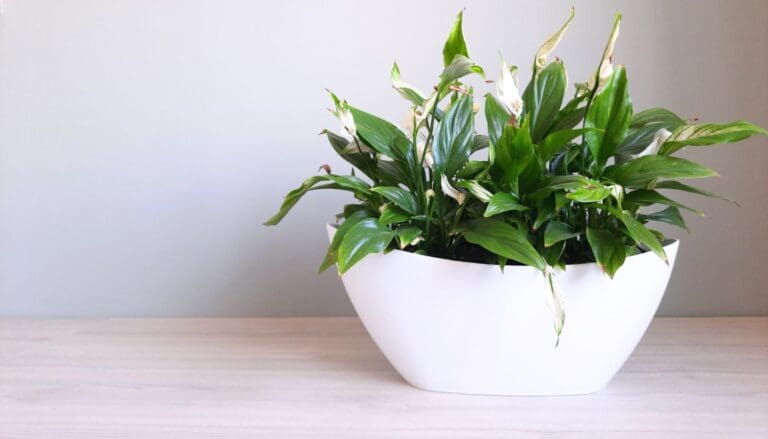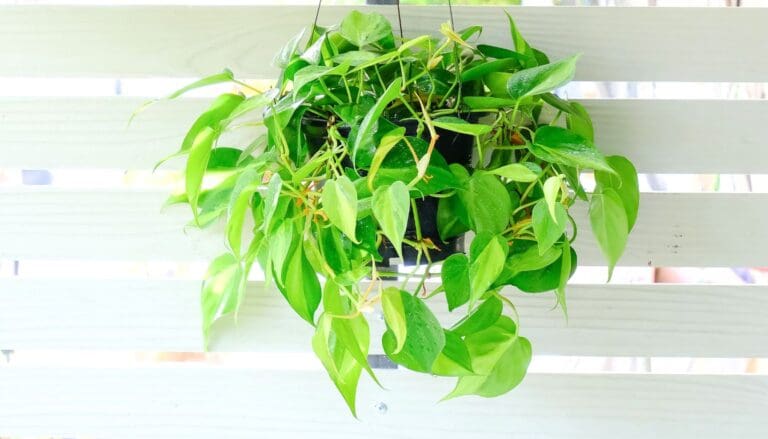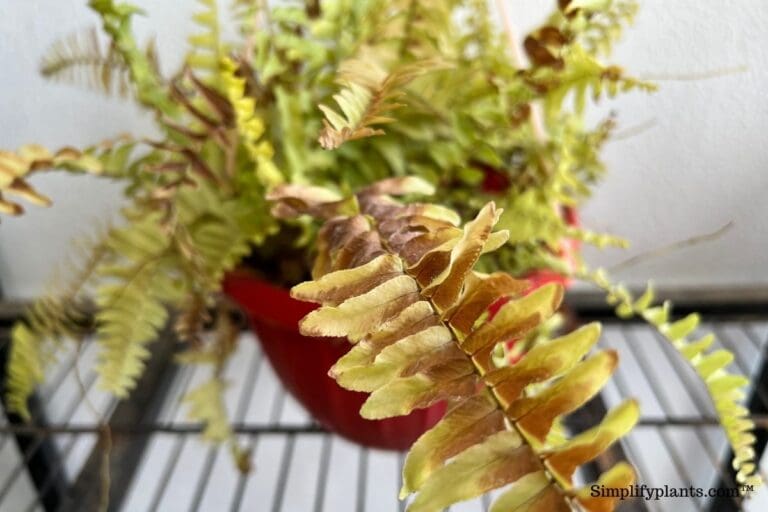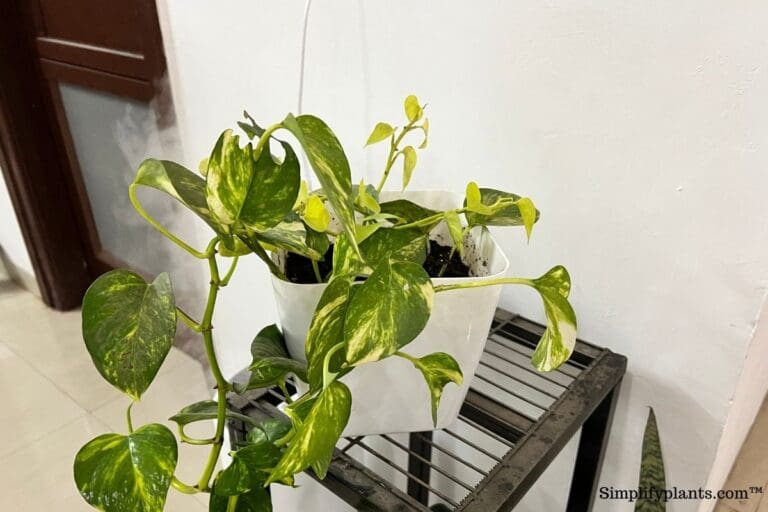How To Save English Ivy From Root Rot? (Signs, Causes & Fix)
English ivy is a low-maintenance plant resistant to most minor problems, making it ideal for beginner gardeners. However, among the few major issues that kill English ivy is root rot.
To fix an English ivy with root rot:
- Inspect the roots.
- Remove all the decaying and mushy roots.
- Apply fungicide over the healthy ones.
- Prepare a fresh soil mix and get a new pot.
- Repot the ivy in the fresh soil.
- Water only when the soil is dry, and keep the plant in a well-ventilated area.
This article will discuss ways to save your English ivy if it has been infected with root rot. I will also explain the various signs and the reasons that lead to root rot to prevent root rot in your ivy.

Please note: Simplify Plants is reader-supported. Some links in the post are affiliate links and I get a commission from purchases made through links in the post.
What is root rot?
Root rot is a disease that occurs in the roots of plants due to wrong conditions like wet and mushy soil.
The wet soil cuts off the oxygen supply to the roots suffocating them and becoming a breeding ground for fungus that gradually decays the roots and kills the plant.
Signs of root rot in English ivy
English ivies are sensitive to overwatering and cannot live in wet soil.
They need slightly drier soil and are extremely prone to root rot.
When the rot-causing pathogens attack the roots, the healthy white roots gradually decay, turn black, and die.
The decaying roots fail to provide the plant with nutrients and energy from the soil that the plant needs to grow, gradually killing the plant.
The ivy plant shows several early signs of root rot.
However, if the root rot progresses to the entire plant, the chances of saving the plant become quite low.
Let us discuss some early signs of root rot in your ivy:
1. Stunted growth
When roots are damaged in a plant, they become weak and lose their strength to perform regular activities.
It fails to get nutrients to the plant, which makes it lack the energy to grow.
2. Yellow and pale leaves

A healthy English ivy will have crispy green leaves with variegations.
But when root rot attacks the plant, bright green leaves start to lose their colors and turn pale green and yellow.
If you notice young, healthy leaves starting to turn yellow, this could be one of the early signs of root rot.
3. Black and brown spots
As the fungus progress, the yellowing advances to browning, and the leaves begin to grow brown and black spots.
As the rotting spreads further, these leaves turn entirely brown.
4. Foul smell from the soil
As the root rot begins to spread, they emit a bad odor.
The soggy soil obstructs airflow to the roots, due to which the roots become unable to breathe and decay and emit a bad smell.
If you notice a stench from the soil of your ivy, then be careful, as this might be one of the signals of root rot.
5. Wilting
The rotten roots of the ivy are incapable of carrying out their functions for the plant.
As a result, the plant begins to weaken and lose its energy and strength, due to which they wilt.
Wilting is a plant’s attempt to save the loss of moisture and nutrients from its leaves.
As the rot progresses, wilting is the plant’s frantic effort to save itself from collapsing.
6. Mushy brown roots
If you notice the roots of a healthy plant, you will see they are white, crisp, and fresh.
But if the roots begin to decay, those fresh roots turn brown and get mushy.
They lose their crisp texture and become soft and soggy.
Reasons behind root rot in English ivy
English ivies are very sensitive to wet soil.
Excellent drainage and a dry soil condition is required for the roots to stay healthy.
Multiple reasons cause rot rotting in ivies which we will elaborately discuss below:
1. Overwatering

The primary and most common cause that leads to rotting is overwatering.
You must let the soil of your English ivy dry out in between waterings.
Unlike many plants that need consistently moist soil, English ivies thrive in slightly drier soil conditions.
A prolonged state of overwatering keeps the soil waterlogged, which blocks the flow of air in the roots.
The roots begin to rot as the rot causes pathogens to invade the weak roots and turn them mushy and frail, which cannot help the plant.
The weakened and damaged root system further makes the plant prone to pests and fungus.
2. Poor drainage
Having an excellent drainage system for ivies is important.
The presence of a drainage hole is of extreme importance.
It has to be noted that you must never purchase pots without drainage holes at the bottom.
No matter how fancy they look.
The holes at the bottom help to flow out the excess water helping the soil dry out quickly, which is important for ivies.
If there are no drainage holes, the excess water after watering stays inside the pot and keeps the soil muggy, increasing the chances of rot.
Also, sometimes we forget to empty the cache below the pots where the water accumulates.
This water keeps the bottom of the pots wet and can lead to root rot.
3. Heavy soil mix
The role of the soil mix is very important, and incorrect soil is a common cause of root rot.
Heavy clayey soil retains a lot of water and moisture in the soil.
They stay compact and do not allow airflow in the soil, thus keeping it wet for longer.
Thus if you grow English ivy in clayey soil, root rot ad fungal infection can occur.
These plants require very light well-draining soil that does not retain water and lets air reach the roots.
4. Incorrect pot size and material

The size and the material of the pots you grow your ivy in are equally important.
If you use a pot that is too big for the plant, it holds much more soil inside than required.
This keeps the soil wet for a long time, increasing the chances of fungus attacks.
Ideally, the pot should not be more than 2-inches bigger than the size of the root ball.
The material of the pot should always be porous to help the airflow in the soil.
Nowadays, plant growers use fancy decorative pots made of plastic, ceramic, metal, etc., that are non-porous and do not let air flow into the soil, suffocating the roots and causing a ground for pests to attack.
5. Low light
English ivies grow best in bright partial light.
Keeping plants in low light conditions increases the chances of root rotting.
This is because, in lower light conditions, the evaporation rates are much lower, so the soil stays wet for a longer period.
The soil dries up quickly when plants get ample light, reducing the chances of overwatering.
Plants kept in low lights also become ideal for pest and fungus breeding because they thrive in damp and dark conditions.
6. Poor ventilation
Placing the plant in a well-ventilated spot is vital for the plant.
The spot with good air circulation will help the soil to dry quickly, and the moisture will evaporate quickly.
If the spot you keep your ivy in does not have air circulation, the air stays damp, which suffocates the plant and keeps it damp for a longer time.
7. Using contaminated tools and sick plant
Rot-causing pathogens can invade your ivy through the contaminated tool you use on your plants.
If one of your plants had root rot and you treated that plant with tools and used them on your healthy plant without sterilizing them, you are giving rise to pathogens attacking it.
If you buy a sick plant from the nursery without examining it thoroughly, you also increase the chances of pathogens attacking your plant.
8. Low temperatures
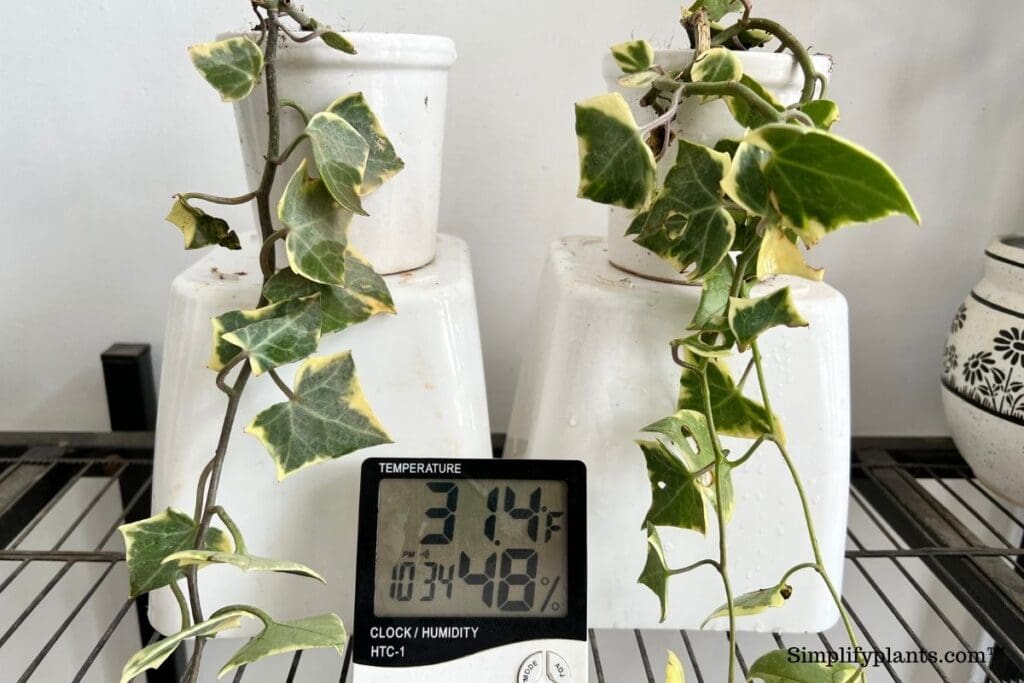
English ivies are natives of Europe, where the temperature stays cooler.
However, if the temperatures become too cold, the plant suffers from the chances of overwatering.
The ideal temperature for ivies is between 70-90°F, and when the temperature goes below 50°F, the plant suffers.
This is why during winters, when temperatures drop excessively, you must cut down on watering and allow the soil to dry out completely until watering it again.
This is because, in winters, the cold, damp soil and low light intensity increase the chances of fungus attacks.
9. Pathogenic infestations
English ivies are prone to pathogenic infestations.
Overwatering makes the plant prone to bacterial and fungal problems.
Phytophthora, Botrytis, and Pythium rot are the main fungi that cause rot rots.
These fungi grow in damp and soggy soil ideal for their breeding.
Once they attack, they tend to expand in the soil rapidly and spread to the entire plant quickly.
10. Using contaminated soil
Reusing the old soil that already has rot-causing fungi to grow new plants also leads to causing root rot.
It is recommended to use fresh soil mix for your plants.
However, if you wish to use the existing soil, you need to sterilize it before using it to prevent the spread of contamination.
How to save an English ivy with root rot?

If you notice the root rot early, you can save your ivy by following certain steps.
Repotting is the best way to save the ivy from root rot causing germs by changing the entire soil, clearing the rotten parts, and replanting it in fresh soil.
Let me talk about the steps you need to follow in case you suspect root rot in your ivy:
1. Take the ivy out of its pot
If you doubt that your ivy has been attacked by root rot, you first need to take the plant out of the pot to check the condition of the root ball.
To begin with, remember repotting is a difficult process for plants, and you need to be as gentle as possible.
Turn the pot upside down and gently tap the bottom with your elbow; the plant will come out easily.
Do not pull it by force.
2. Clean and examine the roots
Next, you need to see the condition of the roots.
For this, wash the roots properly under running water to remove all the soil attached.
3. Prune the rotten roots
Then you take a pair of sharp pruning shears and wipe it with rubbing alcohol to sterilize it.
Then trim all the mushy and soft roots of the ivy with it.
Be careful not to trim the healthy roots and only remove the black and soft ones.
Once done, sterilize the pruner again and remove all the infected leaves and branches of the plant.
Trimming these parts will reduce the plant’s stress and help it focus its energy on producing healthy leaves.
4. Arrange the pot
You should take a new pot to repot the plant as the previous pot has been filled with germs.
Choose a pot 2 inches bigger than the root ball and no bigger than that.
Also, ensure it has drainage holes and is preferably made of clay.
If you do not have access to a new pot, disinfect the existing pot before using it again.
To disinfect the pot, soak the pot in a tub containing a solution of 80% water and 20% bleach.
Bleach will kill all pathogens and germs.
Let the pot soak for 20 minutes, then keep it dry under the full sun.
5. Use a fungicide
Then, fill a large tub with water and mix 1 teaspoon of fungicide.
Then put the plant in this mixture and leave it for 15 minutes.
The fungicide will kill all the bacteria and pathogens attached to the roots.
After 15 minutes, take the plant outside ad keep it at a bright indirect spot for some time to dry off the water.
6. Prepare fresh soil mix
Prepare a loose well-draining potting mix perfect for your ivy.
For this mix, use:
- 2 parts fresh soil
- 1 part sand
- 1 part perlite
- 1 part compost
- A handful of crushed charcoal
Fill up half of the pot with this potting mix.
7. Repot the ivy
Place the English ivy carefully at the center of the soil, add soil from all sides, and press it gently to fill up the air pockets in the soil.
Water the plant thoroughly until it drains out o the drainage holes, then keep it at a spot that receives bright light and proper ventilation.
8. Observe the plant
Always water the plant only when the top layers of the soil are dry.
Observe how the plant is doing.
It might appear wilted for a few days, but it should bounce back as a hardy-resistant plant.
How to prevent root rot in English ivy?

Now that we have learned about the causes of signs and treatment to cure root rot in your English ivy let us learn how to prevent root rot and keep your ivy healthy.
- Water the English ivy when the top layers of the soil are dry. If you are unsure if your ivy needs water, use a moisture meter to read the moisture content in your soil. In case you do not have it, use the finger test. Poke your finger in the soil, and I the soil sticks to your skin, do not water. If the soil does not stick, then water.
- Reduce watering drastically in fall winters and during rainy days.
- Do not keep the ivy plant in low-light areas.
- Do not use a pot without drainage holes.
- Use artificial lights if you do not have enough natural light in your home.
- Keep your ivy in well-ventilated areas with plenty of airflows.
- Do not keep your plant too close to each other, as that restricts airflow between them.
- The potting soil of your ivy has to be loose and have good drainage. Do not prepare compact clayey soil. If your soil is too tight, add sand, compact and crushed charcoal to improve the texture of the soil and make it lose.
- Do not use a pot that is more than 2 inches bigger than the root ball.
- Clay pots are highly recommended over plastic, ceramic, and other non-porous materials.
- Fertilize only during the growing season with an NPK 20-20-20.
- Always sterilize any tools you use in your garden before and after use.
- Maintain the correct temperature ranges for your ivy.
- Repot the plant every 2-3 years with a fresh soil mix.
Reference: Researchgate, University of Tennessee, Mississippi State University, Central Florida Research and Education Center, U.S. DEPARTMENT OF AGRICULTURE.
Recommended Garden Supplies
| Product Image | Our Recommended Gardening Supplies | Check Offers! |
|---|---|---|
Top Top
Top
Top
Top
Top
Top
Top
Top | rePotme Houseplant and Tropical Classic Potting Soil Mix | Check Offer On Amazon |
 Top
Top
Top
Top
Top
Top
Top
Top | Espoma Organic Indoor Plant Food | Check Offer On Amazon |
 Top
Top
Top
Top
Top
Top
Top
Top | GooingTop LED Grow Light 6000K Full Spectrum Clip Plant Growing Lamp | Check Offer On Amazon |
 Top
Top
Top
Top
Top
Top
Top
Top | Soil Moisture Meter | Check Offer On Amazon |
 Top
Top
Top
Top
Top
Top
Top
Top | Govee Hygrometer Thermometer, Bluetooth Enabled! | Check Offer On Amazon |
 Top
Top | LEVOIT Humidifiers for Large Room(Best For Plants) | Check Offer On Amazon |
 Top
Top
Top
Top
Top
Top
Top
Top | Upgraded DIY Automatic Drip Irrigation Kit, 15 Potted Houseplants Support | Check Offer On Amazon |
 Top
Top
Top
Top
Top
Top
Top
Top | Stainless Steel Heavy Duty Gardening Tool Set | Check Offer On Amazon |
 Top
Top
Top
Top
Top
Top
Top
Top | Bonide Insecticidal Soap | Check Offer On Amazon |
 Top
Top
Top
Top
Top
Top
Top
Top | Bonide 32 oz Spray Neem Oil for Organic Gardening | Check Offer On Amazon |
 Top
Top
Top
Top
Top
Top
Top
Top | Garden Safe Fungicide | Check Offer On Amazon |

